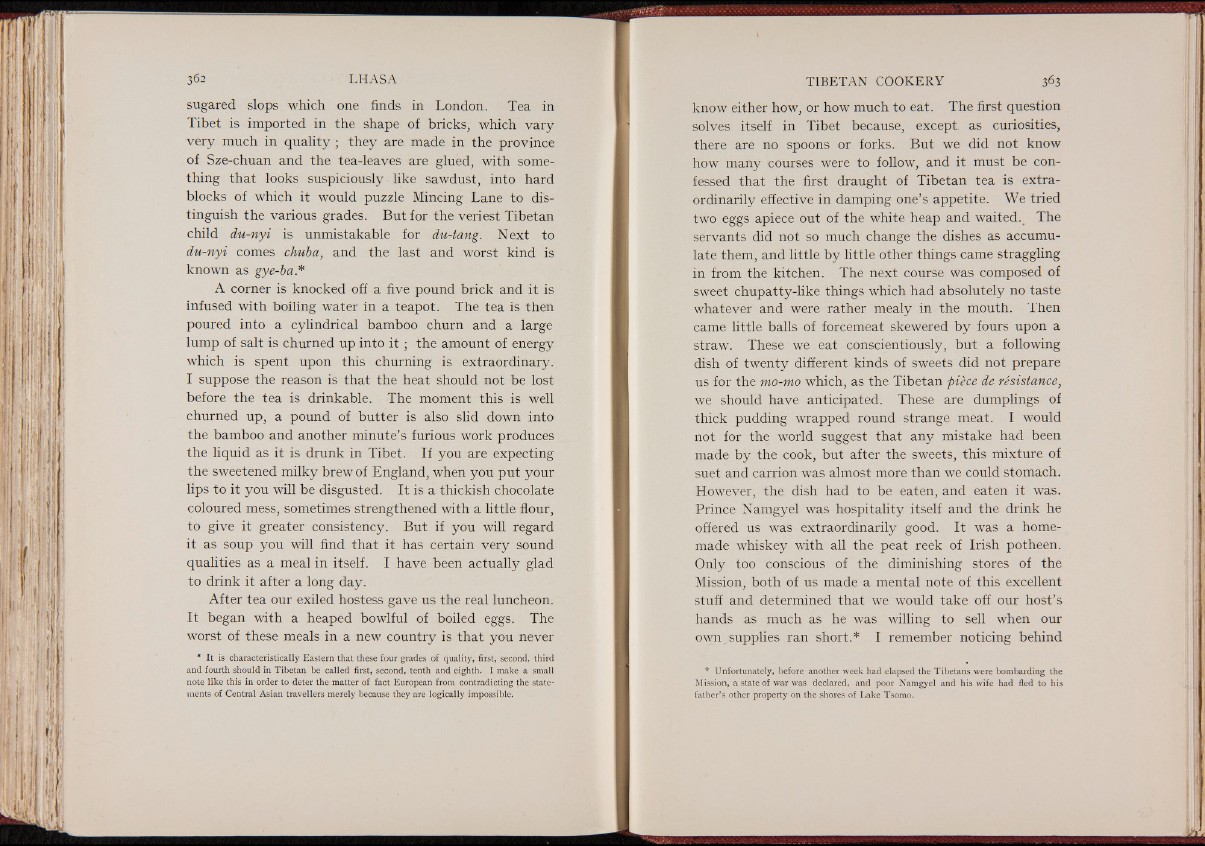
sugared slops which one finds in London. Tea in
Tibet is imported in the shape of bricks, which vary
very much in quality ; they are made in the province
of Sze-chuan and the tea-leaves are glued, with something
that looks suspiciously like sawdust, into hard
blocks of which it would puzzle Mincing Lane to distinguish
the various grades. But for the veriest Tibetan
child du-nyi is unmistakable for du-tang. Next to
du-nyi comes chuba, and the last and worst kind is
known as gye-ba*
A corner is knocked off a five pound brick and it is
infused with boiling water in a teapot. The tea is then
poured into a cylindrical bamboo churn and a large
lump of salt is churned up into i t ; the amount of energy
which is spent upon this churning is extraordinary.
I suppose the reason is that the heat should not be lost
before the tea is drinkable. The moment this is well
churned up, a pound of butter is also slid down into
the bamboo and another minute’s furious work produces
the liquid as it is drunk in Tibet. If you are expecting
the sweetened milky brew of England, when you put your
lips to it you will be disgusted. It is a thickish chocolate
coloured mess, sometimes strengthened with a little flour,
to give it greater consistency. But if you will regard
it as soup you will find that it has certain very sound
qualities as a meal in itself. I have been actually glad
to drink it after a long day.
After tea our exiled hostess gave us the real luncheon.
It began with a heaped bowlful of boiled eggs. The
worst of these meals in a new country is that you never
* It is characteristically Eastern that these four grades of quality, first, second, third
and fourth should in Tibetan be called first, second, tenth and eighth. I make a small
note like this in order to deter the matter of fact European from contradicting the statements
of Central Asian travellers merely because they are logically impossible.
know either how, or how much to eat. The first question
solves itself in Tibet because, except as curiosities,
there are no spoons or forks. But we did not know
how many courses were to follow, and it must be confessed
that the first draught of Tibetan tea is extraordinarily
effective in damping one’s appetite. We tried
two eggs apiece out of the white heap and waited^ The
servants did not so much change the dishes as accumulate
them, and little by little other things came straggling
in from the kitchen. The next course was composed of
sweet chupatty-like things which had absolutely no taste
whatever and were rather mealy in the mouth. Then
came little balls of forcemeat skewered by fours upon a
straw. These we eat conscientiously, but a following
dish of twenty different kinds of sweets did not prepare
us for the mo-mo which, as the Tibetan pièce de résistance,
we should have anticipated. These are dumplings of
thick pudding wrapped round strange meat. I would
not for the world suggest that any mistake had been
made by the cook, but after the sweets, this mixture of
suet and carrion was almost more than we could stomach.
However, the dish had to be eaten, and eaten it was.
Prince Namgyel was hospitality itself and the drink he
offered us was extraordinarily good. It was a homemade
whiskey with all the peat reek of Irish potheen.
Only too conscious of the diminishing stores of the
Mission, both of us made a mental note of this excellent
stuff and determined that we would take off our host’s
hands as much as he was willing to sell when our
own supplies ran short.* I remember noticing behind
* Unfortunately, before another week had elapsed the Tibetans were bombarding the
Mission, a state of war was declared, and poor Namgyel and his wife had fled to his
father’ s other property on the shores of Lake Tsomo.